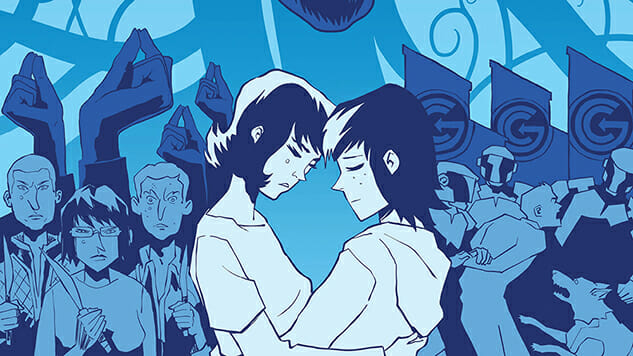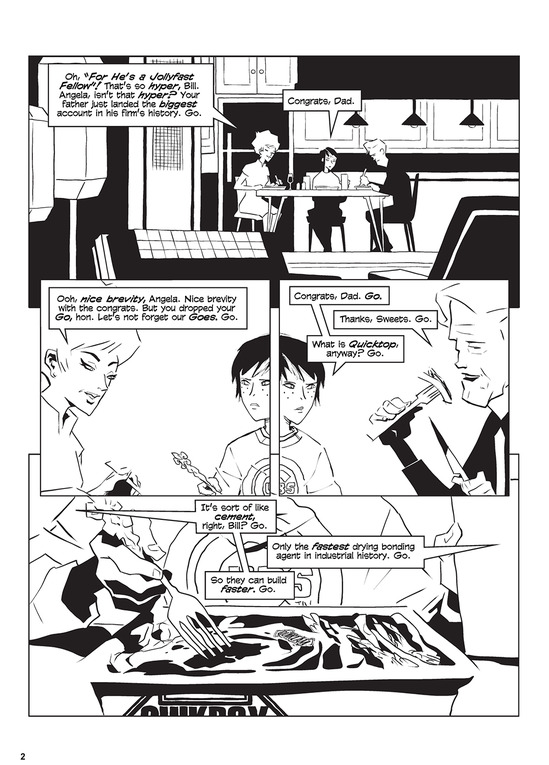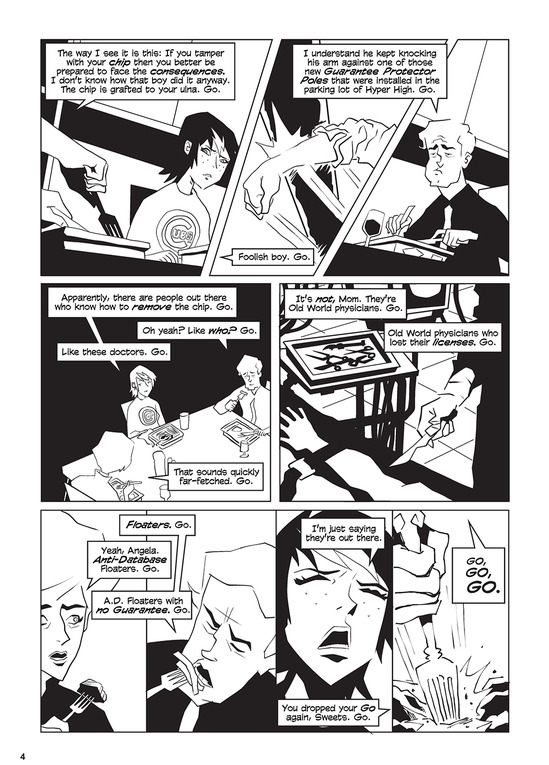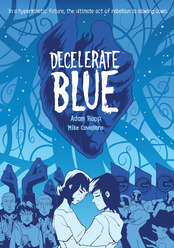The Tyranny of Efficiency: Adam Rapp on Writing the Intellectual Dystopia of Decelerate Blue
Comics Features Adam Rapp
Humanity has officially crossed the threshold where the rate of information processed has exceeded the ability to digest it—we exist in a flurry of shifting screens and rotating tasks. Finding moments of balance, times to detach and pause, is getting more and more difficult. Adam Rapp and Mike Cavallaro’s new graphic novel, Decelerate Blue, takes that distraction to extreme, uncomfortable levels—a dystopia that will slide from fiction to reality in a matter of time.
In this society, efficiency and speed supersede all: classic novels are abridged, beds are forgotten in lieu of sleep-standing and the phrase “Go. Guarantee. Go.” stands as a default motto for life. Angela, the book’s protagonist, is a young woman who bristles at these constraints, and hears rumors of an alternative community that values quality over expediency. In that avenue, an unlikely romance blossoms.
Paste chatted with Rapp—a Pulitzer finalist playwright and novelist—about the project’s long history, his rapport with artist Cavallaro and the setting’s development. ![]()
Paste: A suppressed book lies at the center of Decelerate Blue, and characters encounter it in different forms and editions. Were you drawing from specific moments in the history of samizdat as you showed the influence of this work, and the different ways in which it was encountered?
Adam Rapp: In all honesty, I never really thought of samizdat. I was thinking specifically about how a novel, an actual bound artifact, could survive the world, even a world that no longer has a place for it. I liked this idea because everything is on screens now. We read fiction, news, Twitter, engage with almost all forms of information on a digital format, whether it’s a smartphone, a pad or a laptop. I wanted a book to transcend this. To represent permanence and hope.

Decelerate Blue Interior Art by Mike Cavallaro
Paste: The earliest mention I could find of Decelerate Blue was in an interview with you from 2006. How has the project evolved over time into its current form?
Rapp: The text was almost completely finished over ten years ago. Urged by my editor, Mark Siegel, after the artist, Mike Cavallaro, had made a lot of progress realizing the visual world of the book, I re-tooled the ending. Originally it wasn’t such a blunt tragedy. After speaking with Mark at length, I came up with the idea that Angela herself becomes so still at the end that she transforms into a kind of geological, unavoidable, inevitable fact (doing my best here to avoid a spoiler alert). That was a huge change and I wouldn’t have discovered it if Mark hadn’t pushed me to dig deeper and find more consequence.
Paste: Many of the sympathetic characters in Decelerate Blue lament the loss of the richer language used by the likes of Dostoyevsky and Shakespeare. At the same time, you’re telling the story using the medium of comics, where economy of language is often a virtue. How did you navigate that paradox?
Rapp: That was tricky because of the inherent paradox you mention. I just tried to keep in mind what everyone in the underground was longing for, which essentially is imagination, more silence and the limitlessness of thought. Whereas in the world above, being a diligent consumer, being obedient and celebrating speed and vitality, is the key to being successful, and a kind of “ad” language has been adopted. It’s gotten to the extreme that the “state” is starting to regulate how language is used. The government is now limiting modifiers and adapting classic works of literature in the public school system, making them considerably shorter. Even around the dinner table, families are chastising their children if they aren’t adhering to this new game of language. All of this was important to keep in my head so that it would be legible to the reader not only through the images but through the dialogue as well.

Decelerate Blue Interior Art by Mike Cavallaro
Paste: The phrase “Go. Guarantee. Go.” has a deeply pernicious ring to it, and became quite unsettling as it was repeated over the course of the book. How did you come up with it?
Rapp: I do a lot of work in theatre and when a stage manager calls a show, when he or she is about to request a pre-programmed lighting or sound cue to the operator in the booth, the command is always punctuated with a “Go.” So the stage manager says something like, “Lights 43… Go.” It’s incredibly controlling, as it should be because these cues have to be called with exceptional precision for the rhythm of a play to succeed. That’s where that came from.
Paste: One of the more subtle touches in the book was the shape of the word bubbles used by different characters. When in the process did that become a part of the book’s visual storytelling?
Rapp: That came from the artist, Mike Cavallaro. I started to see that taking shape early in his process. I love how carefully chosen all of those visual details are in the book.
Paste: Throughout Decelerate Blue, there are brief glimpses of the larger world: 15-minute movies are now a thing, and sleeping while standing up has become popular. To what extent were you riffing on contemporary technology here, rather than taking an obsession with speed and efficiency to their most extreme ends?
Rapp: I would say that it was a little bit of both. The idea of the book came to me as I was walking around my neighborhood in the East Village. About ten years ago, I started noticing that pedestrians were walking the very busy streets of New York City with their heads down, engaged with their smartphones. I used to see people reading paperback novels this way. The paperbacks had been replaced by smartphones and this new multitasking talent of walking while texting, while answering emails, while purchasing items off the internet, etc., had emerged. That was really from where the other ideas in the world of the book sprang. Engage with media. Let hi-def screens large and small occupy your imagination, not poetry or prose or art or journalism. This all keeps the mind engaged with a consumerist vocabulary. It keeps one from questioning things. In this constant state, we forfeit our citizenship and allow ourselves to be governed by a totalitarian system of constant surveillance and crowd sourcing. And the faster, more efficient, the more one can get achieved in a day, the better. It’s a world of controlled desperation. Teach your body how to sleep standing up because then you can get to your day that much faster after waking.

Decelerate Blue Interior Art by Mike Cavallaro
Paste: There’s also a minimal, but memorable, use of color in the book—did you have that in mind from the outset, or did that come into play later in the process?
Rapp: This came later and I believe it was Mike Cavallaro’s idea. I love the choice. I find it surprising and incredibly powerful to be suddenly met with all of that color.
Paste: The Underground is portrayed largely sympathetically, but you also show flaws there—and the fact that the physical conditions in which they live aren’t ideal for all the people who sympathize with their cause. Did you feel the need to temper their idealism as the reader learns more about them?
Rapp: No movement is without its flaws. Many of the characters in the Underground are idealists. Many of them are young. I see the movement in the book as an incredibly brave, tenacious, intelligent, but imperfect rebellion. I wanted to point up the idea that being a part of this movement is dangerous on many levels. Having one’s chip removed is at once the greatest expression of one’s personal freedom as well as the greatest medical risk one could take.

Decelerate Blue Interior Art by Mike Cavallaro
